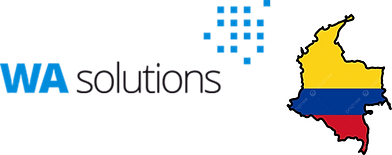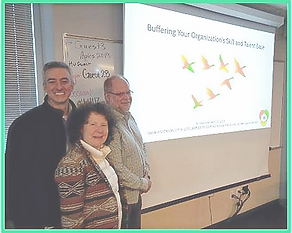

DISCOVER THE SKILL BUFFERS TO SOLVE THE DILEMMA BETWEEN COMPETENCE AND COMPETITIVITY



Building skills to transform the company into a DDAE: Demand Driven Adaptive Enterprise
Excerpted from Appendix A
p. 185, The Demand Driven Adaptive Enterprise by Carol Ptak and Chad Smith (Industrial Press, 2018)
Excerpted from Appendix A
p. 185, The Demand Driven Adaptive Enterprise by Carol Ptak and Chad Smith (Industrial Press, 2018)


The Demand Driven Skills Model
Much has been written about how a Demand Driven Operating Model (DDOM) protects and promotes flow with stock, time, and capacity buffers in companies facing competition in today’s VUCA (volatile, uncertain, complex, and ambiguous) world. What about the people and skills that it takes to operate, support, and adapt a DDOM?
Too many businesses experience symptoms of flow disruption due to missing skills at critical times. Depending on how often and how long it takes to find an alternative, skills scarcities are like bottlenecks, obstructing a company’s profitability, growth, and capability to innovate.
In order to anticipate future flow bottlenecks due to missing skills, decisions to finance hiring or training for specific skills are taken at the strategic level, with feedback loops at the tactical level to secure implementation. A visual approach to priorities can be used in a similar fashion as stock, time and capacity buffers. Assessment of the company's buffer enables monitoring of the progress in change management.
Used in combination with the DDOM, the DDSM allows visualization of where, in its own complex system of departments and workshops, a company must invest to protect its flow (figure 1).
To acquire and maintain the essential resource of human skill, the DDSM addresses where the priorities are by means of a fourth buffer type, a skill buffer, to be used in combination with the other buffers of the DDOM.

Fig.1 : Example of a DDSM combined with its DDOM including a Drum Buffer Rope, during DDI trainings
The Skill Buffer Symbol
The symbol for the skill buffer is a head shown in profile, facing left (when no training is in progress) or right (when training is in process); red, yellow, or green in colour; marked with a number from 1.0 to 4.0. Red means there is a short-term risk to flow if only one employee can manage 100% of processes related to the skill. Yellow anticipates a risk of insufficient contingency for variability. Green means all is good.
This first step is the visual approach to gaining missing skills per department. As a second step, when a company has gained maturity in protecting flow, the colors can be used to show internal trainers’ availability to teach innovation that will promote flow in each of the key processes of the company.

The Multiskills Matrix
The numbers shown in the skill buffer symbol derive from a simple calculation based on the Multiskills Matrix (figure 2). This grid describes the level of skill each employee can demonstrate for any function.
All the functions will be listed in order to encompass all the processes of the company.

Fig.2 : The four levels of skill in the Multiskills Matrix
The requirements for each level must be customized to each company’s activity and maturity.
The number shown on the skill buffer symbol indicates the average level of employee skill, calculated using the green squares, that a group of skills, a function or a department can demonstrate.
As with all Demand Driven buffers, color is considered first. Then, within the highest priority color, strategic decisions about training plan priorities start with the group of functions having the lowest number.

Fig.3 : DDSM promoting innovation: calculation for two departments shown in Fig.1 before DDI trainings
The requirements for each level must be customized to each company’s activity and maturity.
The number shown on the skill buffer symbol indicates the average level of employee skill, calculated using the green squares, that a group of skills, a function or a department can demonstrate.
As with all Demand Driven buffers, color is considered first. Then, within the highest priority color, strategic decisions about training plan priorities start with the group of functions having the lowest number.

The requirements for each level must be customized to each company’s activity and maturity.
The number shown on the skill buffer symbol indicates the average level of employee skill, calculated using the green squares, that a group of skills, a function or a department can demonstrate.
As with all Demand Driven buffers, color is considered first. Then, within the highest priority color, strategic decisions about training plan priorities start with the group of functions having the lowest number.
The requirements for each level must be customized to each company’s activity and maturity.
The number shown on the skill buffer symbol indicates the average level of employee skill, calculated using the green squares, that a group of skills, a function or a department can demonstrate.
As with all Demand Driven buffers, color is considered first. Then, within the highest priority color, strategic decisions about training plan priorities start with the group of functions having the lowest number.
Project launched in March 2019 in Oregon USA following the DD Word
conference with a DDSM workshop in Frankfurt of October 2018
Progress as of August 2024:
Testimonial: "We monitor the progress of our DDSM during a monthly meeting with production supervisors.
This year, we have new equipment with several new operators and a supervisor. The DDSM helps us identify areas where we need to focus our training efforts. Progress is sometimes slow, but the visibility provided by the Skills Buffer is important to us. I'm glad we implemented this model." Craig JOLLY Production Manager



Project launched after a DDSM workshop in April 2019, in Minneapolis, USA
by John MELBYE, affiliated with the Demand Driven Institute,
by Juan Camilo TRUJILLO, CEO of WA Solutions.
Implementation of a DDSM by the WA Solutions team,
for all WA Solutions staff, online, between late 2019 and 2021.



Juan Camilo TRUJILLO
CEO of WA solutions
The same at the DDworld 2024
Juan, Caroline, John
The project began after an AEF (Adaptive Enterprise Foundation) training course in July 2017 at the Ecole Centrale de Lyon France during the FAPICS - DD World conference.
Implementation of a DDSM in all Ingelec workshops of Casablanca in Morocco.

The DDSM project began in Mitry with 2 DDSM workshops in February 2022 for 14 managers.
It was continued in October 2024 with 5 managers from Mitry and 1 from the AL group.

Demand Driven Skills Model
Groupe 1 Air Liquide Mitry
Février 2022

Demand Driven Skills Model
Groupe 2 Air Liquide Mitry
Mai 2022

Demand Driven Skills Model
Groupe 3 Air Liquide Mitry
Octobre 2024 à janvier 2025

The DDSM project began in Mitry with 2 DDSM workshops in February 2022 for 14 managers.
It was continued in October 2024 with 5 managers from Mitry and 1 from the AL group.



Project launched in March 2019 in Oregon USA following the DD Word
conference with a DDSM workshop in Frankfurt of October 2018
Progress as of August 2024:
Testimonial: "We monitor the progress of our DDSM during a monthly meeting with production supervisors.
This year, we have new equipment with several new operators and a supervisor. The DDSM helps us identify areas where we need to focus our training efforts. Progress is sometimes slow, but the visibility provided by the Skills Buffer is important to us. I'm glad we implemented this model." Craig JOLLY Production Manager
Project launched in March 2019 in Oregon USA following the DD Word
conference with a DDSM workshop in Frankfurt of October 2018
Progress as of August 2024:
Testimonial: "We monitor the progress of our DDSM during a monthly meeting with production supervisors.
This year, we have new equipment with several new operators and a supervisor. The DDSM helps us identify areas where we need to focus our training efforts. Progress is sometimes slow, but the visibility provided by the Skills Buffer is important to us. I'm glad we implemented this model." Craig JOLLY Production Manager

Pod cast du dirigeant de YELHOW
Le flux de compétence facteur clé d’une croissance pérenne de l’entreprise
Dans ce nouvel épisode des VISCONTI TALKS, Caroline MONDON, partner coach chez VISCONTI, reçoit Baptiste GENDRON, fondateur et dirigeant de la société Yelhow, éditeur de logiciels qui propose des applications mobiles et web sur étagère pour les femmes et les hommes de terrain de l’industrie, afin de les aider dans leur quotidien. Baptiste GENDRON est ingénieur de formation, sérial entrepreneur depuis 15 ans dans l’industrie ou il a notamment conçu et développé la solution de tests et essais du dernier avion d’Airbus l’A350 ou encore développé des systèmes d’hypervision 4D pour les centres de commande spatiaux. Il nous explique comment avec YELHOW, il contribue à rendre les entreprises plus performantes et résilientes en mettant en adéquation leur savoir faire et leurs ressources humaines avec leur stratégie de développement, grâce à un traitement en temps réel des informations du terrain pour avoir les bonnes personnes bien formées, au bon endroit et au bon moment.



































